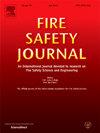Inhibition mechanism of bio-based phytic acid chelate-mediated interfacial assembly of Mn and Ni: Elucidation by experiment of downward flame spread and analysis of thermal degradation with TG-IR-MS
IF 3.4
3区 工程技术
Q2 ENGINEERING, CIVIL
引用次数: 0
Abstract
Due to the increased risk of phosphate depletion, there is an increasing demand for low-phosphorus or bio-based phosphorus flame inhibitors. Therefore, two novel composites with biologically-based phosphorus sources that chelate transition metal ions were synthesized via assembly method, i.e., Mn-PMC and Ni-PMC, the structure and binding states of the composites were examined by SEM, TEM, FTIR, XRD, XPS, BET and TGA. The results indicated that Mn-PMC and Ni-PMC (ⅰ) are nanoscale materials with well dispersed, (ⅱ) have an amorphous structure and have sites that bind to other substances, (ⅲ) contain no halogen elements. Then the combustion inhibition experiments of downward flame spread and TG-IR-MS analysis revealed (ⅰ) that the inhibition efficiency of the two prepared inhibitors was higher than that of commercial phosphate-containing inhibitor ADP. Among them, Ni-PMC had the best suppression effect, and the flame of cellulose sample containing it would automatically extinguish after igniting with a smallest dosage, (ⅱ) two inhibitors reduced the laminar flame velocity and flame temperature. (ⅲ) their flame suppression mechanism was indicated as that the pyrolysis releases inert gas to dilute the free radical concentration. This work is helpful for the development of efficient transition metal fire extinguishing agents to replace traditional phosphorus resources.
生物基植酸螯合物介导的Mn和Ni界面组装的抑制机制:火焰向下扩散实验和热降解TG-IR-MS分析
由于磷酸盐耗竭的风险增加,对低磷或生物基磷类阻燃剂的需求不断增加。因此,通过组装法合成了两种新型的生物基磷源螯合过渡金属离子复合材料Mn-PMC和Ni-PMC,并通过SEM、TEM、FTIR、XRD、XPS、BET和TGA对复合材料的结构和结合状态进行了表征。结果表明:Mn-PMC和Ni-PMC(ⅰ)是分散良好的纳米材料;(ⅱ)具有无定形结构,具有与其他物质结合的位点;(ⅲ)不含卤素元素。向下火焰蔓延的燃烧抑制实验和TG-IR-MS分析表明:(ⅰ)两种制备的抑制剂的抑制效率均高于市售的含磷酸盐抑制剂ADP。其中,Ni-PMC抑制效果最好,含有Ni-PMC的纤维素样品在点燃后火焰自动熄灭,用量最小;(ⅱ)两种抑制剂降低了层流火焰速度和火焰温度。(ⅲ)其抑焰机理为热解释放惰性气体稀释自由基浓度。本研究为开发高效过渡金属灭火剂替代传统磷资源提供了依据。
本文章由计算机程序翻译,如有差异,请以英文原文为准。
求助全文
约1分钟内获得全文
求助全文
来源期刊

Fire Safety Journal
工程技术-材料科学:综合
CiteScore
5.70
自引率
9.70%
发文量
153
审稿时长
60 days
期刊介绍:
Fire Safety Journal is the leading publication dealing with all aspects of fire safety engineering. Its scope is purposefully wide, as it is deemed important to encourage papers from all sources within this multidisciplinary subject, thus providing a forum for its further development as a distinct engineering discipline. This is an essential step towards gaining a status equal to that enjoyed by the other engineering disciplines.
 求助内容:
求助内容: 应助结果提醒方式:
应助结果提醒方式:


